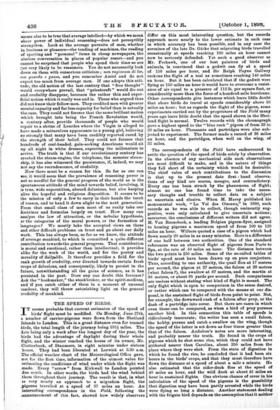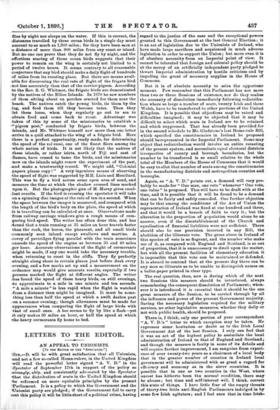THE SPEED OF BIRDS.
IT seems probable that current estimates of the speed of birds' flight must be modified. On Monday, June 27th, a number of carrier-pigeons were flown from the Shetland Islands to London. This is a great distance even for trained birds, the total length of the journey being 5911 miles. The date being only a week after the longest day of the year, the birds had the advantage of daylight during their whole flight, and the winner reached the house of its owner, Mr. .Clutterbuck, of Stanmore, in eight minutes under sixteen hours. They had been liberated at Lerwick at 3.30 a.m. The official weather chart of the Meteorological Office gave, not for the first time, information of the utmost value for estimating the conditions of wind under which the flight was made. Every "arrow" from Kirkwall to London pointed due south. In other words, the birds had the wind behind them throughout their journey. The result is that, in what is very nearly an approach to a migration flight, the .pigeons travelled at a speed of 37 miles an hour. An interesting correspondence in the Field, following the announcement of this fact, showed how widely observers differ on this most interesting question, but the records approach more nearly to the lower estimate in each case in which accuracy has been possible, and in any case the surmises of the late Dr. Gatke that migrating birds travelled occasionally at speeds reaching 180 miles an hour cannot now be seriously defended. Yet such a good observer as Mr. Frohawk, one of our best painters of birds and animals, is convinced that a godwit can fly at a speed of 150 miles per hour, and Sir Ralph Payne Gallwey reckons the flight of a teal as sometimes reaching 140 miles an hour. But it has been calculated that if the godwit were flying at 150 miles an hour it would have to overcome a resist- ance of air equal to a pressure of 112 lb. per square foot, or considerably more than the force of a hundred-mile hurricane. Other correspondents give instances which leave little doubt that shore birds do travel at speeds considerably above 50 miles an hour ; but as regards the flight of the pigeon, some experiments carried out by the proprietors of the Field many years ago leave little doubt that the speed shown in the Shet- land flight is normal. Twelve records with the chronograph gave a highest speed to the " blue rock " pigeon of from 33 to 38 miles an hour. Pheasants and partridges were also sub- jected to experiment. The former made a record of 38 miles an hour, and the partridges, when well on the wing, of 32 miles.
The correspondents of the Field have endeavoured to settle the question of the speed of birds solely by observation. In the absence of any mechanical aids such observations are most difficult to make, and in the nature of things they fall short of the certainty which would be desirable. The chief valve of such contributions to the discussion is that up to the present date first - hand observa- tions of any kind are scarce, meagre, and contradictory. Every one has been struck by the phenomena of flight; almost no one has found time to take the neces- sary thought and trouble to collect data on a subject so uncertain and elusive. When M. Many published his monumental work, " Le Vol des Oiseaux," in 1890, such records as he was able to collect, though eminently sug- gestive, were only calculated to give uncertain notions; moreover, the conclusions of different writers did not agree. M. Van Roosebeck, a leading Belgian pigeon-flyer, assigned to homing pigeons a maximum speed of from 100 to 120 miles an hour. Wilbers quoted a case of a pigeon which had flown nearly 20 miles in as many minutes. Here is a difference of one half between two authorities. One of the standard references was an observed flight of pigeons from Paris to Spa, at the rate of 50 miles an hour. The distance between the two points is 250 miles. Some of the so-called tables of birds' speed must have been drawn up on pure conjecture. Thus, according to one authority, the quail flies at 17 metres per second, the pigeon at 27 metres, the falcon at 28 metres (what falcon ?), the swallow at 67 metres, and the martin at 88 metres, or about 95 yards per second. Such comparisons are useless without stating what kind of flight is meant. The only flight which is open to comparison in the sense desired, or rather which can be compared with the means at our dis- posal, is the sustained flight of birds from point to point. Not, for example, the downward rush of a falcon after prey, or the dash of a partridge into cover. But there are cases in which even these can be compared, as when a bird of prey pursues another bird. In this connection this table of speeds is ridiculously inaccurate; the writer has seen a small falcon, the hobby, pursue and catch a swallow on the wing, though the speed of the latter is set down as four times greater than that of the falcon. Audubon's notes are more interesting, and probably nearer the truth. He found in the crops of pigeons which he shot some rice, which they could not have gathered nearer than Carolina, about 350 miles from the place where they were shot. From the state of digestion in which he found the rice, he concluded that it had been six hours in the birds' crops, and that they must therefore have flown the distance at a speed of about a mile a minute. He also estimated that the eider-duck flies at the speed of 40 miles an hoar, and the wild duck at about 45 miles an hour in sustained flights. One obvious chance of error in his calculation of the speed of the pigeons is the possibility that digestion may have been partly arrested while the birds were flying so long a distance. Another statement dealing with the frigate bird depends on the assumption that it neither flies by night nor sleeps on the water. If this is correct, the .distances travelled by these ocean birds in a single day must amount to as much as 1,800 miles; for they have been sin at a distance of more than 900 miles from any coast or island. But no one can prove that they do not fly by night, and the -effortless soaring of these ocean birds suggests that their -power to remain on the wing is certainly not limited to a period of twelve hours. It seems contrary to all reasonable conjecture that any bird should make a daily flight of hundreds of miles from its roosting place. But there are means avail- able for discovering the real rate of flight of the frigate bird -not less accurately than that of the carrier-pigeon. According to the Rev. S. G. Whitmee, the frigate birds are domesticated by the natives of the Ellice Islands. In 1870 he saw numbers .of them sitting about on perches erected for them near the beach. The natives catch the young birds, tie them by the -leg, and feed them till they become tame. Then they let them loose, when they regularly go out to sea to -obtain food and come back to roost. Advantage was taken of this by some of the missionaries to establish a -"pigeon post," conducted by frigate birds, between the -islands, and Mr. Whitmee himself saw more than one letter -arrive in a quill attached to the wing of a frigate bird. Here there is a perfect opportunity, ready made, for determining the speed of the vol ram's, one of the finest fliers among the whole nation of birds. It is not likely that the natives of these islands, or rather islets, north of Fiji and east of -Samoa, have ceased to tame the birds, and the missionaries now on the islands might renew the experiment of the past, -and make a trustworthy record. We might add, "Colonial -papers please copy ! " A very ingenious means of observing -the speed of flight was suggested by MM. Liais and Mouillard. This was to fly a bird across some open area of sand, and measure the time at which the shadow crossed lines marked upon it. But the photographic gun of M. Marcy gives excel- :lent results. If the bird is crossing the spectator it will take on a spinning disc images at the rate of ten in a second. When the space between the images is measured, and compared with 'the length of the bird's body on the plate, the speed at which it is travelling can be calculated at once. Observations made -from railway carriage windows give a rough means of com- paring bird speed. The writer has often done this, and has ifound that a train running at 35 miles an hour travels faster than the rook, the heron, the pheasant, and all small birds .commonly seen inland except swallows and martins. A .covey of partridges flying parallel with the train sometimes -exceeds the speed of the engine at between 35 and 40 miles „per hour. Accurate observations of the flight of cormorants -might be made, if any one would take the necessary trouble, when returning to roost in the cliffs. They fly perfectly -.straight along shore in certain places just before dusk every --evening, and a few marks set up and a measurement on the -.ordnance map would give accurate results, especially if two persons marked the flight at different angles. The writer ..has found the speed of these heavy birds, on still evenings, to approximate to a mile in one minute and ten seconds. "A mile a minute" is less rapid when the flight is watched :from a distance than might be imagined. It must be some- thing less than half the speed at which a swift dashes past -.on a summer evening; though allowances must be made for appearances when comparing the flight of large birds with that of small ones. A bee seems to fly by like a flash—yet it only makes 30 miles an hour, or half the speed at which 'the heavy cormorants fly home to bed.







































 Previous page
Previous page